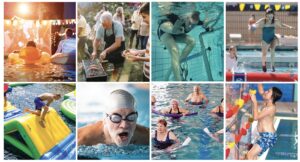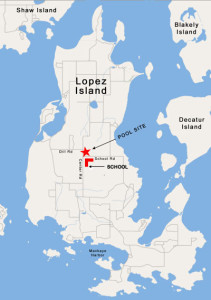by Claire Anderson | Feb 22, 2024 | News
The Dream Has Arrived:
THE POOLS ARE HERE!
The two Myrtha pools arrived on Lopez on January 30th and are in storage on Pool Lane.
We are eagerly anticipating the culmination of the construction campaign to close the gap in fundraising. We’re almost there, and getting closer every day, thanks to your ongoing support. The Islands will Swim!
___________________________________________________________________
 Winter Appeal Brings in More Than $720K!
Winter Appeal Brings in More Than $720K!
We are thrilled to announce that our 2023 Winter Appeal was a tremendous success, raising $723,154.35! We would like to express our sincere gratitude to all of our donors who generously contributed to this important fundraising effort. Thanks to your support, we are getting closer to construction. We truly could not have done it without you. You are making the dream come alive!
P.S. Did you donate to FLIP in 2023? If you’d like a duplicate report of your tax-deductible giving, we can help! Please contact info@lopezislandpool.org.
___________________________________________________________________
“Pool Progress: Behind the Scenes of the Lopez Swim Center” is an eight-part informational series about the Lopez Swim Center. These articles are possible thanks to a Lopez Thrift Shop grant. This is part five of the series: FLIP interviews Stu Isaac of Isaac Sports Group, FLIP’s Aquatic Advisor.
Financial Sustainability & Membership at the Lopez Swim Center
FLIP: How did you approach this project?
Our first steps were to understand the unique elements of Lopez Island and how they impact the Swim Center’s development and operation. We viewed this through the lens of best practices that apply to all aquatic facilities, as well as our extensive research on Puget Sound area swim facilities.
What is the Center’s model for operating and how will it be affordable to all?
FLIP is a nonprofit business, combining the best of public and private swimming models. Similar to any business, it needs to be financially sustainable, but as a nonprofit, it also must be affordable to all. A financial assistance program was established to provide discounts of 50%, 75%, and, in special cases, 90%. This was one of the most important outcomes of our business planning.
The Center will not rely on levies or taxes for funding. Instead, it relies upon user fees and pool passes, which make up 65% of overall revenue. The estimates of pool-pass sales is also conservative, with Year One projections at only 68% of projected full use by Year Three.
Summer-season prices will reflect peak demand, and allow annual and monthly pool-pass prices to be kept low for the nonpeak season (eight months of the year). We strongly feel the pool-pass projections are very conservative. These projections assume that, by Year Two, only 14% of Lopez families with children under 18 will have an annual Swim Center family pool pass. The market penetration for seniors is even lower, with our senior annual pool-pass projections showing only 9% of Lopez seniors having passes. We estimate adult-specific annual pool-pass sales to only 10% of adult residents. Overall, we project that 19% of Lopez year-round residents will have some type of monthly or annual pool pass at the Swim Center.
Having two pools offers the ability for concurrent programming, providing more opportunities for fun and significantly bolstering the Center’s financial sustainability. A wide range of programs, such as swimming lessons, special events (birthday parties or sunset gatherings at the pool), facility rentals, and a variety of classes, will generate an additional 31% of gross revenue, with only 4% of the total revenue coming from annual fundraising. |
|
…I am now very confident in the financial viability and the budget projections for the Swim Center—and in the incredible game-changer the Center will be in the overall quality of life for all Lopez Island residents.
—Stu Isaac, FLIP Aquatic Advisor
|
Pools are expensive to run; how is this any different?
Expense projections were based on best-practice operations to keep the Swim Center safely operating for years to come. We worked closely with Water Technology Inc. (WTI), the project’s aquatic engineers, to identify key technologies that reduce maintenance costs, as well as energy, water, and chemical use. The operational savings pay for the incremental cost of the technology in the first two to three years of the Center’s operation; the return on investment over the long term is very good. Utility costs constitute less than 10% of total operating costs, which is also excellent. Staffing costs make up 60% of total operating costs, which is right in line with best-practice aquatic facilities around the country.The Center has made strategic decisions to limit costs. For example, instead of having a permanent water slide, FLIP will rotate flexible activities, from inflatable obstacle courses to pool log-rolling, which collectively cost just 20% of what a water slide would cost and do not require additional assigned lifeguards at the top and bottom of the water slide. Rotating activities keep programs fresh so that people want to come back. We feel that the expense model for the Swim Center is realistic and conservative.
What about long-term maintenance and equipment replacement?
FLIP secured an initial donor commitment of $510,000 to seed its Capital Reserve Fund (CRF). Our budget projections predict net annual revenue beginning in Year 3, which will allow the Center to allocate funds to the CRF over subsequent years, accruing $1.85M by Year 20. Besides the CRF, the Center’s budget provides best-practice maintenance funding to meet all equipment maintenance requirements and recommendations to limit unexpected capital maintenance needs.
What provides some assurance of the Center’s financial sustainability?
We worked with a bottom-up approach and only consolidated revenue and expense totals at the very end, without targeting specific financial results. This approach ensures the accuracy of our projection, and gives both FLIP and us strong confidence in the validity of the operating budget. Over the course of our research, program design, and development of the business model, I am now very confident in the financial viability and the budget projections for the Swim Center—and in the incredible game-changer the Center will be in the overall quality of life for all Lopez Island residents. |
by Claire Anderson | Jan 10, 2024 | News
Attend Friends of Lopez Island Pool’s annual (virtual) public board meeting, with election of officers and committee updates and reports. Time at the end of the meeting will be available for public questions.
Lopez Swim Center Public Board Meeting (Online)
Jan 18, 2024
5:00 – 6:30 pm
Online (Zoom) Meeting
Please email director@lopezislandpool.org for the Zoom virtual meeting link.
by Claire Anderson | Dec 31, 2023 | News
FLIP’s 2023 series of informational interviews with pool experts and articles on pool progress was made possible by a generous grant from the Lopez Thrift Shop. We greatly appreciate their support in helping spread the word about the Lopez Swim Center!
by Claire Anderson | Dec 26, 2023 | News
“Pool Progress: Behind the Scenes of the Lopez Swim Center” is an eight-part informational series about the Lopez Swim Center. These articles are possible thanks to a Lopez Thrift Shop grant. This is part five of this series: FLIP interviews Stu Isaac of Isaac Sports Group, FLIP’s Aquatic Advisor.
FLIP: How did you approach this project?
Our first steps were to understand the unique elements of Lopez Island and how they impact the Swim Center’s development and operation. We viewed this through the lens of best practices that apply to all aquatic facilities, as well as our extensive research on Puget Sound area swim facilities.
What is the Center’s model for operating and how will it be affordable to all?
FLIP is a nonprofit business, combining the best of public and private swimming models. Similar to any business, it needs to be financially sustainable, but as a nonprofit, it also must be affordable to all. A financial assistance program was established to provide discounts of 50%, 75%, and, in special cases, 90%. This was one of the most important outcomes of our business planning.
The Center will not rely on levies or taxes for funding. Instead, it relies upon user and membership fees, which makes up 65% of overall revenue.
Summer season prices will reflect peak demand, and allow annual and monthly membership prices to be kept low for the nonpeak eight months of the year. We strongly feel the membership projections are very conservative. These projections assume that only 14% of Lopez families with children under 18 will have a Swim Center family membership. The market penetration for seniors is even lower, with our senior membership projections showing only 10% of Lopez seniors. Adult-specific memberships project to 12% of adult residents.
Overall, we project that 18% of Lopez year-round residents have some type of membership in the Swim Center. Having two pools offers the ability for concurrent programming, providing more opportunities for fun and significantly bolstering financial sustainability. A wide range of programs, such as swimming lessons, special events (birthday parties and sunset gatherings at the pool), facility rentals, and a variety of classes, generate an additional 35% of gross revenue, with only 4% of the total revenue coming from annual contributions.
Pools are expensive to run; how is this any different?
Expense projections were based on best-practice operations to keep the Swim Center safely operating for years to come. We worked closely with WTI, the project’s aquatic engineers, to identify key technologies that reduce maintenance costs, and energy, water, and chemical use. The operational savings pay for the incremental cost of the technology in the first two to three years of the Center’s operation; the return on investment over the long term is very good. Utility costs constitute less than 10% of total operating costs, which is also excellent. Staffing costs make up 60% of total operating costs, which is right in line with best-practice aquatic facilities around the country. The Center has made strategic decisions to limit costs. For example, instead of having an expensive permanent slide, FLIP will rotate flexible activities, from inflatable obstacle courses to pool logrolling, which collectively cost 20% of a water slide and do not require additional assigned lifeguards. Rotating activities keeps programs fresh so that people want to come back. We feel that the expense model for the Swim Center is realistic and conservatively at the high end of the range.
What about long-term maintenance and equipment replacement?
FLIP secured an initial donor commitment of $510,000 to seed its Capital Reserve Fund (CRF). Our budget projections predict net annual revenue beginning in Year 3, which will allow the Center to allocate funds to the CRF over subsequent years, accruing $1.85M by Year 20. Besides the CRF, the Center’s budget provides best-practice maintenance funding to meet all equipment maintenance requirements and recommendations to limit unexpected capital maintenance needs.
What provides some assurance of the Center’s financial sustainability?
We worked from the bottom-up and only consolidated totals at the very end, without targeting specific financial results. This bottom-up approach ensures the accuracy of our projection and gives both FLIP and us strong confidence in the validity of the operating budget. Over the course of our research, program design, and development of the business model, I am now very confident in the financial viability and the budget projections for the Swim Center—and in the incredible game-changer the Center will be in the overall quality of life for all Lopez Island residents.
by Claire Anderson | Dec 8, 2023 | News
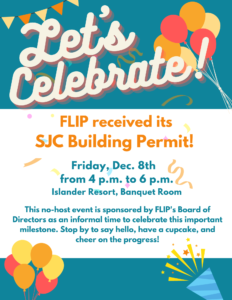
by Claire Anderson | Oct 26, 2023 | News
FLIP Letter to the Community
FLIP is grateful for the many years of generous support from our community. FLIP’s support from 1,300+ donors has reinforced the strong need and desire for a Lopez Swim Center, for water safety of our kids and adults, for our community’s health and mobility, and for a year-round gathering place for all ages and all incomes.
Over the past two years, project revisions have been made to economize the project, refine equipment choices, and update financial operating projections to reflect today’s economy. We appreciate your patience as plans and operating impacts were finalized. In an effort to efficiently respond to as many questions as possible, we’re sharing the following update.
Project Costs, Operating Costs, Transparency
Updated Project Costs: Since FLIP’s original plans, the economy has changed, construction costs have risen significantly, and more eco-friendly technologies have been identified. This led to FLIP embarking upon a comprehensive update that included a facility redesign to eliminate the more costly natatorium, simplify shower-house facilities, and revise aquatic equipment to ensure maximum water and energy savings while improving pool water/air quality and reduce chemical use. The original County permit application of July 2018 was amended with updated design and construction-level drawings in May 2023. The review process is proceeding smoothly with no concerns. While the construction bid details are still being finalized, we expect the remaining fundraising gap to be less than $2 million.
Updated Financial Operating Projections: FLIP’s original financial operating forecasts developed in 2017/2018 have been updated to account for the current economy and operating environment, as well as the revised facility. To ensure the projections were rooted in best practices, we brought in aquatic experts, the Isaac Sports Group (ISG), to ascertain long-term financial sustainability and community impact. ISG’s expertise is in privately funded projects and public/private partnerships, areas where conventional public approaches often falter. ISG dedicated months to grasp the intricacies of Lopez’s operating environment, engaging with local community groups, comprehending market dynamics, and understanding the unique challenges of Lopez.
- Projections reflected in the Summary of Financial Projections (see previous post) encompass all operational aspects, from equipment and staffing to maintenance and program planning. These projections have been meticulously researched with operating pools, rigorously challenged, and thoroughly refined within a detailed 35+ page operating budget.
- Why has the operating budget grown? Under the guidance of ISG, FLIP’s budget grew in both revenue and expenses to align with today’s opportunities and costs. Income and expense budgets were built independently from the bottom up, based upon similar operations. ISG first identified all available income opportunities and enhanced our plans to include activities not previously identified, such as summer camps. Cost escalation required adjustments at nearly every level. For example, the original budget planned lifeguard wages of $15 per hour and are now planned at a starting wage of $20+ per hour.
- How are we planning for capital replacements and repairs? The Capital and Maintenance Reserve Fund will grow from an initial $510,000 pledge to $1.89 million over 20 years and will be funded from operating income. This fund covers capital replacements, including the dome, as well as equipment maintenance and repair.
- Will FLIP take on debt? To finance the purchase of the heat pumps, FLIP plans to utilize OPALCO’s Switch It Up program, a low-interest loan payable over 10 years. FLIP will also utilize a bridge line of credit, common in capital campaigns, to provide cash against the value of pledges/commitments from donors and state awards.
- What is FLIP’s “plan B” if projections don’t work out? The financial plan is scalable, without affecting the Swim Center’s viability. Our detailed projections are conservative for both revenue and expenses, and include opportunities for additional revenue and cost savings. For example, while no other pool in San Juan County has full-time lifeguards, FLIP has budgeted for full-time lifeguards. We will have the ability to adjust staffing hours during slower winter periods. Once the Swim Center is open, there are also grants available to support programming activities.
- Will Lopezians be taxed? No, FLIP is not considering a public taxing district. Our model is entrepreneurial: a nonprofit venture that treats the Swim Center as a business, and requires practices that optimize the balance of income and expenses. Public funding would raise our costs substantially due to specific requirements. Sustainable swim centers thrive as entrepreneurial setups, allowing us to manage operation hours and staffing efficiently.
Transparency: FLIP posted a link to request financials on its website, has held multiple town halls and community meetings, and has held open-to-the-public Board meetings for the past 11 years. It is only during the last couple of years, as FLIP explored project revisions to simplify the facility and its impacts, that sharing updated data was challenging as revisions were being made. Now, after painstaking work to update costs, we are pleased to share summary financial projections. This will be posted on our website, and we will continue to hold public meetings to provide updates.
A More Economical Plan
What about the dome? One major cost-savings measure was the decision to capitalize on the island’s summer season with an outdoor pool and provide shelter with an air-inflated dome during winter. Not only does this save the capital cost of the natatorium but it eliminates the energy use of a dehumidification system during warmer months.
Today’s domes are long-lived and come with high-efficiency air-handling systems. Arizon Building Systems was chosen first and foremost because it is an air-handling company and understands how to ensure a comfortable swimming environment. Domes are used throughout the world; many sports facilities use them year-round. Swimming pools use domes seasonally, with multiple examples in the Puget Sound area, including three on Mercer Island. The dome membrane comes with a 20-year warranty, but real-world experiences reflect a 25-year+ lifespan. Regardless, the dome membrane replacement is a planned expense in the capital reserve fund at Year 20. At the end of its working life, the membrane can be repurposed and used as tarps. A premium fabric option is available without PFAS; information on this will be posted on our website.
The FLIP project team spent many months researching alternative covered structures for community pools. Some creative ideas are not possible due to strict State code regulations for community pools. Alternatives did not reduce capital costs and would have increased heating/dehumidification needs (and thus operating costs and energy usage).
Will it be a saltwater pool? Although plans initially called for a saltwater pool, further analysis necessitated a changeup for the following three reasons: 1) Fisherman Bay Sewer District will not allow salt water in their sewer system, as it disrupts the natural biologics they need to maintain for the health of the sewer system; 2) saltwater pools would have required additions of chlorine to adhere to State health codes. Saltwater pools have chlorine generated by a saltwater chlorinator, which also consumes more energy than chlorine pools, and needs to be augmented with chlorine in pools with greater numbers of swimmers; and 3) greater expense, as the highly corrosive nature of salt water would have damaged equipment, required more frequent replacements, and necessitated specialized maintenance workers.
Growth & Lopez
How can a small community support a swim center? The pool’s revenue base extends beyond full-time residents to a variety of sources, including seasonal membership and drop-in fees, swimming lessons, day- and week-long camps, special events, and retail sales. Four key user groups have been identified: full-time residents, part-time residents (and their family/friends/grandchildren), a small number of users from neighboring islands (primarily Orcas and Shaw), and visitors. Forty-five percent of the Swim Center’s revenue is projected to be generated during summer months (peak demand) when San Juan County Visitor Bureau states 80,000 unique visitors come to Lopez. A small amount of fundraising is planned primarily focused on supporting financial assistance for those in need.
Managing growth is important for Lopez. Preserving open spaces while working within our tourism-driven economy is vital. The Swim Center offers local activity in a commercially zoned area with several established businesses; it is an open lot located within walking distance of the K-12 public school. Focusing growth in specific areas preserves our natural spaces. But we can also imagine how the surrounding property can be carefully cultivated so it’s “more than just a pool:” BBQs, ping pong, community gardens, and native plantings with more trees have all been suggested as viable options.
Energy efficiency: Recent facility and equipment updates focus on energy and water conservation. For example, instead of traditional sand filters, which would consume 22,000 gallons of water monthly, we are investing in regenerative media filtration systems that use just 740 gallons monthly. Heat pumps and pool covers are two of the many additional ways that the Swim Center will reduce its energy and water consumption. For more information, see our website.
Enhancing community health: This project represents 1,300 community voices, of all types, who have stepped up time and time again to say this is important: for water-safety, for year-round fitness, for health and healing, and for connection. With only 8% of our island K-5 students passing the Red Cross’s basic swim competency test, swim lessons are crucial (for adults too!). The Swim Center will offer water-safety skills beyond swim lessons, such as kayak safety and water-rescue training. The warm water wellness pool will be a place to build strength and mobility. It will be a year-round gathering place for all ages, abilities, and incomes.
The health and mental well-being of our community is why income and expense budgets were built independently from the bottom up, based upon similar operations. Early on, FLIP established partnerships to complement existing community groups, including Lopez Island Physical Therapy, Lopez Island School District, Lopez Island Family Resource Center, Lopez Fire & EMS, and Lopez Community Trails Network. A multifaceted partnership with the Lopez Island School District includes integrating swim lessons and water activities into the K-12 PE curriculum so that every Lopez student will graduate knowing how to swim. Afterschool and preschool activities are being coordinated with the LIFRC. Water activities are shown to help with anxiety, one more way that the pools will support a healthier community.
Stronger together. FLIP is committed to maintaining open discussions and adjusting our project based upon community needs. We appreciate the questions that have been raised. We look forward to continued dialogue.
This article series is supported by a grant from the Lopez Thrift Shop.
by Claire Anderson | Oct 24, 2023 | News
Lopez Swim Center | Summary of Financial Projections, October 2023
Highlights
- A low-interest loan through OPALCO’s Switch It Up program will pay for heat pumps. A bridge loan/line of credit will be utilized for cash flow during construction to cover donor pledges and State commitments.
- Conservative revenue and expense projections target financial sustainability for the Lopez Swim Center by Year 3, with contingency planning built into the projections.
- A capital and maintenance reserve fund has been seeded with $510,000 (Year 1), grows to $775,000 (Year 10) and $1.89M by Year 20. These funds are earmarked for equipment repair / replacement and are funded from operations.
- A diversified income stream, including memberships and daily/weekly passes, swim lessons, camps, special events, and retail sales, will help ensure the Center’s financial sustainability.
- The Lopez Swim Center will draw upon four user markets, including full-time and part-time residents and their families and friends; residents of neighboring islands; and seasonal visitors.
- The majority of revenue (67%) will be generated by Memberships & Daily Use fees; 45% of this revenue is projected during summer months, when Lopez tourism peaks with 80,000 visitors over a 13-week period according to the SJC Tourism Bureau. Market penetration for full-time Lopezians obtaining annual memberships are conservative and includes discounted memberships between 50-90% for those needing financial assistance. Projections are that annual revenue generated from Lopez full-year and school-year memberships constitute only 37% of the gross income each year.
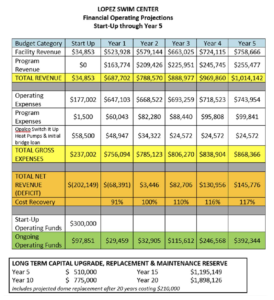


by Claire Anderson | Oct 3, 2023 | News
Pool Progress “Pool Progress: Behind the Scenes of the Lopez Swim Center” is an eight-part series to keep you informed with project updates, along with interviews from Swim Center experts, leaders, and community members supporting the campaign. This is part three of our eight-part series.
Meet Some of FLIP’s Pool Pros
In recent years, the expertise for the Lopez Swim Center’s planning, implementation, and operation has significantly expanded. Today, nearly 40 volunteers serve on six committees dedicated to project oversight, operations, fundraising, marketing, financing, and advising. Here, we highlight four of FLIP’s volunteer leaders—professionals in their respective fields who are contributing their skills and expertise to create the best swim center possible for the community.
Leading the Creative Charge 
Executive Creative Director and partner of Graphiti, one of Seattle’s top digital creative agencies, Kevin Berger leads the firm’s creative vision and strategic direction. He works with national and global clients including Amazon, Munich Re, Colliers, and Nordstrom. He also has more than a decade of experience in board and volunteer facilitation from working with groups like AIGA, a national organization of design professionals. Graphiti led the rebranding campaign for San Juan Preservation Trust to achieve more inclusive participation in stewarding land conservation efforts. As a FLIP volunteer on the Marketing Committee, Kevin’s focus is creating a cohesive message and visual identity for the Swim Center.
FLIP: What marketing expertise have you and Graphiti brought to this project and how are you guiding the Swim Center’s branding and marketing?
KB: I’ve been able to tap into Graphiti’s broader team and donate some of our services to help support several aspects of FLIP’s marketing. Early on, we developed a communications plan that focused on generating excitement and awareness about the new pool. We also designed several renderings of the new pool to give the public an idea of the experience.
Another area where Graphiti’s team provided support was helping FLIP develop a video from ad agency creative writer (and Lopezian) Dave O’Hare’s written manifesto, which can be found on FLIP’s website. The manifesto grounds the project in a guiding vision; putting it on the website is a way for everyone to be able to see it and share in that vision.
FLIP: Are there any teasers you can share about the Swim Center’s branding effort?
KB: Yes! In collaboration with Dave, we’ve developed our “North Star” brand statement: “To surprise and delight everyone.” We’ll be doing that with opportunities that are inviting, fun, respectful, and, we hope, will generate a lot of enthusiasm. So, I’ll leave that to your imagination to envision where that might lead visually.
FLIP: Why did you join FLIP’s leadership? What most impresses or excites you personally about the project or the leadership?
KB: As a part-time Lopez resident (I’ve been a part of the community for more than a decade), I am invested in the island’s preservation and health. I want to see my community not only become a safer place with regards to water safety but want people of all ages to have a safe and healthy place to gather, exercise, and share new skills. I joined FLIP because I wanted to support a great group of longtime locals who were working towards these same goals. I knew my brand and marketing experience could really help, and I’ve never looked back. It’s been a very positive experience!
Monitoring Construction Efficiency & Cost 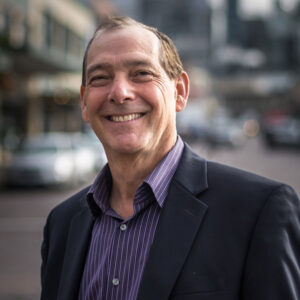
For 40 years, architect Eric Meng has led Studio Meng Strazzara’s design work, serving the Northwest’s leading public institutions, including K12 schools and universities, dozens of public pool facilities, and numerous recreational and performing arts facilities. He developed Meng Analysis, providing value engineering, constructability, facility condition, and performance analysis for major building and infrastructure projects worldwide. A past board member for the American Institute of Architects, he has served 30 years on Washington state’s construction advisory panel. He is a globally recognized leader for applying value management to design. Eric is a vital member of FLIP’s Project Committee, reviewing and providing essential feedback on the Swim Center’s design parameters and sustainability. As a highly respected architect, you bring expertise in value engineering, constructability, facility condition, and performance analysis.
Can you share what guidance you’ve provided as a FLIP Project Committee member?
EM: First, I’d like to point out that Kris Betty contributed a huge amount of expertise and energy leading the project committee as the project went through a long metamorphosis to get it to where it is today. The project has a competent design team, but ultimately, FLIP, as the owner, needs to make the decisions that ensure this project responds to community needs, and that it can be built within the tough budget parameters.
Since Bill LeDrew recruited me about two years ago to this committee, I have encouraged FLIP to seek some independent analysis to evaluate the project design, cost, and constructability. That has informed some desired changes and the selection of a very engaged contractor. The plan we are pursuing now is well balanced for cost, practicality, energy efficiency, and long-term sustainability. The constant challenge has been to balance the desire for a fully functional pool with the realities of the construction budget. My goal was to be sure that any cost-cutting measures would not have a detrimental impact on the pool’s long-term performance or maintenance. The most significant change was the pool cover structure, which in the end will result in a far more sustainable operation and provide an experience that takes advantage of the great Lopez summer weather.
What is most important for the community to know about the planning behind the Swim Center project? What gives you confidence in its design?
EM: Every detail of the project plan has gone through a long and arduous review and optimization. In addition to review by the project committee and the contractor, I hired a team of independent experts with whom I’ve worked professionally to conduct a constructability assessment. This thorough evaluation of the project’s design was very important to ensure there would be no delays from our end when the project was under permit review.
What was your motivation for joining FLIP’s project committee?
EM: When I was growing up, my parents were very active in getting a community pool in our local town of Normandy Park. As a result, I spent a good part of my free time as a teenager at the pool. This project is so important—especially for teens.
The Swim Center is going to be such a vital part of the Lopez community. What impresses me most about is the quality of the leadership and volunteer teams working on this project. They are experienced, professional, and genuinely interested in excellence for the facility as well as the organization. I have been part of a multitude of projects like this—mostly public and community—and the FLIP team of outstanding individuals and the way they work together outshines many.
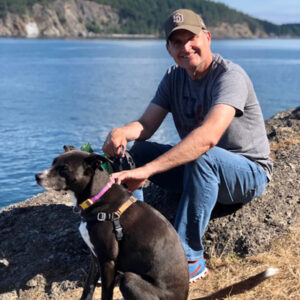 Pool Programming: Fitness & Fun
Pool Programming: Fitness & Fun
Matt Newman’s 30-year career in recreation and athletics includes extensive experience in aquatics operations. As the University of Washington’s director of recreation, he has helped lead planning design for the institution’s major pool and locker room renovation project, currently in progress. In prior positions, which called for creative programming for mixed-use pools, Matt excelled in striking a balance for all pool users at locations as diverse as The Evergreen State College and the Weyerhaeuser King County Aquatic Center. As a FLIP board member and on the Operations Committee, he lends his decades of experience to ensuring robust and responsive pool programming for the community.
As a new FLIP board member, what encourages you most about this project and its future operation?
MN: I’m impressed by the commitment of FLIP’s group of people—folks like Bill, Linda, Robin, Micki, and others—who’ve been at this a long time. They’ve never lost sight of the mission that we need a pool on Lopez. As we prepare for future operations, it’s been helpful to work with aquatic center consultant Stu Isaac on the sustainability model.
Our goal is to open and operate the pool and make it financially accessible for all. The fact that we will have a sustainable business model without having exorbitant membership fees is very impressive to me given how much the pool has to offer.
Describe how the Lopez Swim Center programming will compare to other aquatic centers where you have worked.
MN: At the University of Washington, we are completing a major renovation to expand and update the original pool, which was built in 1968. When the renovated pool opens, we’ll have 14 lanes for lap swimming, compared to the six lanes we have now, plus enough room to dedicate part of the pool to other activities during certain times of the day. At other aquatic facilities where I’ve worked, I faced the ongoing challenge of balancing demand for open swim, dedicated programming/classes, and lap swim. Instead of having more lanes, like UW added, the Lopez Swim Center will have two pools. It’s a game-changer.
First, we’ll be able to accommodate a lot more people. Second, from a programming standpoint, there’s much more flexibility for running different programs at the same time. We can even set the pools at different temperatures. This variable allows us to program our classes with a new level of specificity, such as warmer water for a rehabilitative class. With so much potential for programming, Lopez Swim Center can focus on its mission of teaching everybody to swim while offering a wide variety of additional water activities for health, fun, fitness, and more.
Talk about your passion for Lopez and how this project is part of that.
MN: I have been coming to Lopez for many years. From the beginning, it has felt like home. I’m from Nebraska, and Lopez has a similar feeling to me of where I grew up: It’s the people. Whether they are board members, committee members, folks in the community, or friends I’ve made over the years, Lopez people care deeply about this community. That’s what I am drawn to. It’s why I get more engaged with Lopez every year. The chance to bring my expertise to this project and become a FLIP board member have been the perfect opportunities for me to contribute to the community. It has been very fulfilling, and it is just the beginning for me. Lopez has felt like home for years, and now I’m working toward making it my home.
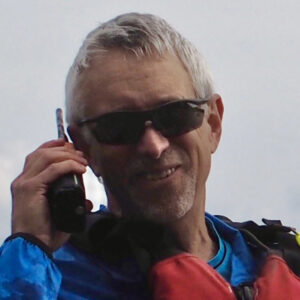
Keeping an Eye on Efficiency
Brian Silverstein brings four decades of experience in the electric utility industry and has served on the board of the local utility cooperative, OPALCO, since 2016. He retired in 2012 as senior vice president of transmission at the Bonneville Power Administration (BPA), a federal utility that provides energy to Northwest consumer-owned utilities. At BPA, he enabled connecting enough wind generation to power more than 500,000 homes. A full-time Lopezian, he collaborates with FLIP as a trusted energy-efficiency advisor for the Swim Center.
With decades of leadership experience in the electrical utility industry, including your current service as a board member of OPALCO, what’s been your role in connecting the Swim Center project to the utility’s low-interest loan program for heat pumps? How will those pumps contribute to energy savings for the Swim Center?
BS: The lowest cost and cleanest way to use energy is to be efficient. The challenge is that not everyone can make an investment even if the payback is fast. The USDA Rural Utility Service is one of OPALCO’s lenders. They offered to fund a program for energy efficiency. OPALCO jumped on it, naming it Switch it Up! It started with residential members and is now available to all members, including nonprofits and businesses. FLIP can apply, like any other member, for a low-interest loan to fund the Swim Center’s energy-saving equipment. It is projected that using electric heat pumps instead of propane-powered ones to heat the two pools, shower house, and dome, will save $440,000 in energy bills over 10 years. Equally important, using electric heat pumps would avoid putting out 750 tons of carbon dioxide a year.
Having served as an advisor for seven years on FLIP’s leadership team, what changes have you seen over the years in the project’s management?
BS: FLIP leadership started with swimming advocates, some of whom had experience with swimming pool operation, finance, communications, and construction. During the time I’ve been involved, the leadership team has brought in more special knowledge, including people to reach out to all the parts of our community who would use the pool.
What is the most inspiring aspect about the Swim Center project or its leadership?
BS: My wife was one who encouraged me to get engaged with the project. After we moved to Lopez, she was one of the volunteers who took elementary-school students to the Anacortes pool for Swim Days, which were sponsored in part by FLIP. She was shocked at how few students had basic water skills.
So besides creating a space where people can learn and practice essential swimming skills, there are two things I’m focused on—getting the pool built and having a facility that is cost-effective and energy efficient. Personally, I’m looking forward to learning to roll a kayak and practicing my water-rescue skills.
This article series is supported by a grant from the Lopez Thrift Shop.
by Claire Anderson | Sep 12, 2023 | News
“Pool Progress: Behind the Scenes of the Lopez Swim Center” is an eight-part series to keep you informed with project updates, along with interviews from Swim Center experts, leaders, and community members supporting the campaign. This is part two of our eight-part series.
Project Updates
Financial Assistance Program. Ensuring the entire Lopez community can access the Swim Center is essential. We are a diverse community with vastly different financial resources, so financial assistance will be available for those individuals and families in need, with significant (50% to 75%+) discounts off standard membership rates.
Lifeguard recruitment! You’ve heard about the lifeguard shortage affecting pools nationwide. We have taken steps to ensure the Swim Center has the lifesaving staff we need. This June, the Swim Center launched lifeguard information sessions and continues to receive sign-ups. Please contact info@lopezislandpool.org if you are interested in becoming a lifeguard or swim instructor.
Discussing Domes, Dollars & Permits
FLIP’s Board Chair Bill LeDrew and Executive Director Anne Marie MacPherson answer questions about the new pools’ progress.
Q: There hasn’t been much news about the Lopez Swim Center this past year—why?
AM: While there’s not been much public news about the Swim Center, the board, staff, project team, and committees have been working diligently behind the scenes to create an even more efficient Swim Center, both in design and operation. It’s been a focused and productive time during which we’ve been laying the foundation for a well-run and financially sustainable swim center. We are excited to share our progress: Join our Town Hall on September 22.
Q: What is happening with project costs? How are you keeping this project attainable?
A: Inflation and other economic drivers over the past two years have contributed to cost escalation affecting this project. In late 2021, our general contractor provided an updated cost estimate that led us to simplify and downsize the facility to reduce costs and ensure that the project remained affordable. We scaled back the showerhouse design and identified more energy-efficient equipment choices. The biggest change was to transition from a natatorium with a retractable roof to a seasonally indoor/outdoor pool with an air-inflated dome.
Q: I keep hearing about the dome. How will it work?
A: An air-inflated dome, or “bubble,” will cover the pools during the cooler months and allow indoor swimming. In warmer weather, the dome will be deflated to allow open-air swimming. We choose Arizon because, first and foremost, it is an air-handling company, specializing in air quality and air flow. The Arizon dome is durable and long-lasting: Arizon’s air-handling system is designed for a 30+ year lifespan, and the fabric is designed for a 20- to 30-year life, with a 20-year warranty. A wind/snow sensor will automatically adjust air flow and a backup generator will kick on in the event of power failure. The dome has a translucent skylight that will allow natural daylight during the day and reduce the need for artificial lighting. Domes are relatively simple to put up and take down. The membrane folds up and can be stored on two large pallets during the warmer months. For more information, view Arizon’s aquatics brochure.
We spent months researching and interviewing facilities that use domes in various climates and locations; all dome users reported being extremely satisfied with the domes’ performance and durability. Three swim clubs on nearby Mercer Island use domes over their pools!
Q: Does the project have all its permits?
A: We are still waiting for our final permits. As you may have heard, the San Juan County Building Department has been overburdened due to staffing and technology challenges. This has resulted in delays in receiving our building permits. The good news is San Juan County Building Department has outsourced our permit application to help expedite the approval process. The review is proceeding, and no concerns have been raised. We have done everything possible to ensure a smooth review on our end.
Q: In what ways is the Lopez Swim Center stronger than ever?
A: We have been using this time to focus on implementation and operations. When the pool opens, we’ll be in great shape to run the Swim Center! Our highly detailed financial projections are based on aquatic trends and facilities with similar communities and programming. We have planned a sustainable operation that will meet the community’s needs for years decades to come.
The Lopez Swim Center has scaled up its leadership with knowledgeable professionals who are guiding the planning, fundraising, construction, and future operations of the Swim Center. Our leadership team has grown exponentially to include volunteer committee members with expertise in key areas (see an upcoming article for interviews with a few of our committee members.)
In addition, we hired nationally renowned aquatic experts Water Technologies Inc. (see WTI article here) to oversee the technical design of the pool and recommend the most effective and efficient equipment. They advised us on the best choices for operating cost, energy, and water efficiency for maintaining a pool on a remote island. For example, although a saltwater pool was initially planned, WTI has counseled that the staffing expertise and maintenance implications of operating saltwater pools wouldn’t be appropriate for our island location.
We are ready to begin construction once the permits are approved and the appropriate funding is in hand. With construction-ready drawings finalized, our general contractor Chad Fisher Construction has lined up the necessary subcontractors for the job.
Q: What is the budget for the project? How much has been raised?
A: We won’t know the final cost of the pool until the permit is approved. We know that costs continue to rise and, despite our budget cuts, there will still be a financial gap. But we are confident that once we receive permits, we’ll be able to close the gap. So far, more than $7 million has been raised from 1,100 donors. Our amazing community has shown how much they want this swim center!
We’re building something on this island that will last for generations. We hope the community will be inspired to join us in this fundraising homestretch. It takes a while to create something great, but it will be worth the wait.
More than just a pool: We are a place for wellness, safety, and fitness, and an all-ages gathering place for the community.
This article series is supported by a grant from the Lopez Thrift Shop.
by Claire Anderson | Aug 31, 2023 | News
Pool Progress: Behind the Scenes of the Lopez Swim Center
FLIP Speaks with Water Technology Inc.’s Ryan Nachreiner
The campaign to build the Lopez Swim Center has retooled and is better than ever after project delays last year that were beyond our control. This eight-part series will provide you with project updates, along with interviews from aquatic experts, leaders, and community members behind the campaign. This is part one of our eight-part series.
PROJECT UPDATES
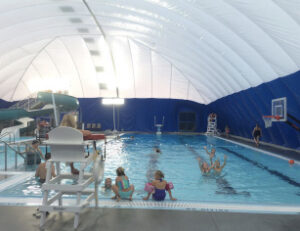
Cost savings—Project leaders made the following planning decisions to reduce project costs without sacrificing quality:
- Simplified design of the shower house
- Selected energy-efficient equipment for lower operating costs and durability
- Became a seasonal indoor/outdoor pool (instead of an indoor pool with a retractable roof) to save both costs and energy. A heated, air-inflated dome will go up in fall for indoor swimming in cooler months. In late spring, the dome will be deflated and stored, for open-air swimming. Left, above: In cold weather, an air-inflated Arizon dome will provide a warm space to enjoy both pools. During the summer, the dome will be removed for open-air swimming.
Timeline—We hope to open the Swim Center in late 2024. Please understand that in our post-COVID world, construction projects remain vulnerable to staffing, cost escalation/funding, and supply-chain issues that could impact this timeline. We are also waiting for the San Juan County permit (see more details in our next article).
Lopez Swim Center Talks with Water Technology Inc.’s Ryan Nachreiner, Regional Director of Project Development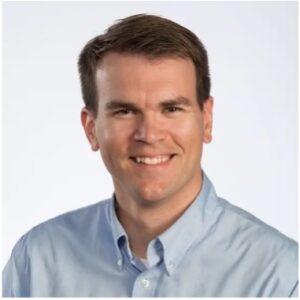
LSC: What is Water Technology Inc.’s role with the Lopez Swim Center project?
WTI: Water Technology Inc. (WTI) is a specialized design firm focused solely on aquatic recreation. For the Lopez Swim Center, we prepared the design and engineering drawings and the specifications for the mechanical and water-treatment systems. These designs are crucial to obtain permit approvals, to bid contract work, and to guide the facility’s construction.
LSC: What is WTI’s experience in the Pacific Northwest and with local regulators?
WTI: WTI has been working in the Pacific Northwest, and Washington state in particular, for over 25 years. As the largest and most experienced aquatic design team in North America, we take a personalized approach to each region where we operate. In the Puget Sound and Salish Sea area, we’ve built a long history and strong relationships with local regulations and code officials.
I live in Bellingham and make a point of being involved in issues affecting our industry at the regional level. I serve on a Department of Health advisory board that is responsible for revisions to state pool codes. WTI also works across the country and in Europe, Asia, and the Middle East developing destination waterparks and family aquatic centers. This experience gives us access to the latest trends and technologies across five continents. No other aquatic firm brings our extensive experience in the Puget Sound and Salish Sea area and the industry knowledge, resources, and technologies from our work around the world.
LSC: Can you talk about some of the equipment that Lopez Swim Center has selected for the new pool?
WTI: Good choices of materials and equipment are crucial for the long-term operation of the facility, especially considering the remoteness of and streamlined staffing operation needs of this facility. Each of the major mechanical components—pumps, filters, controllers, and disinfection systems—are being provided by established companies with highly refined product lines. Equipment was selected for its durability and serviceability. The pools will be constructed using preconstructed steel panels made by Myrtha Pools, a company known for having one of highest quality methods for pool construction with a 25-year warranty. The choice of steel Myrtha pools eliminates the need to for draining them every 3 to 7 years like traditional pools, saving significant water consumption as well as operating costs. With these quality products, the Lopez Swim Center will be able to have manufacturer support over the facility’s lifespan.
LSC: Pools are known to be energy hogs. How are you addressing cost and conservation?
WTI: Pools are energy users, but the Lopez Swim Center has made decisions that significantly reduce its energy consumption. For the Swim Center, we tackled waste and inefficiency in three areas: water and space heating; water filtration; and water circulation / pumping. The most important investment is that the Center will operate with heat pumps powered by electricity. The net result is a 75% reduction in annual operating costs and eliminating the use of 48,000 gallons of propane annually. Secondly, we’ll use advanced filtration with regenerative media filters, which uses up to 90% less water than more common filtration systems, and at the same time, does a better job filtering particles out of the water. This matters because the less water a pool uses, the less energy that’s needed to heat that water.
The largest energy users in pools typically are the pumps that continuously circulate water through the filtration and water treatment system. For efficiency, we’ll have a variable frequency drive on every pump motor directing it to run at precisely the power it needs and preventing wasted energy.
LSC: How does the pool’s design support a positive swimming experience?
WTI: The Lopez Swim Center will offer a broad range of programming for pool users of all ages. There are children learning to swim and retirees keeping healthy and fit, plus a range of swimmers between. To best serve the different pool users and the different types of programming, we designed two separate pools that can be kept at two different temperatures. This allows, for example, the Lopez Swim Center to host water exercise classes in one pool with warmer water to benefit joints and muscles, while keeping another pool at a lower temperature that’s more suitable for lap swimming or swimming lessons. Of course, safe and sanitary water is essential to a positive swimming experience. Advanced filtration and automated UV disinfection systems will continuously provide exceptional water quality; a supplemental sanitation system will provide extra protection against pathogens in addition to the primary disinfection system.
To learn more about the campaign for the Lopez Swim Center contact:
Anne Marie MacPherson, Executive Director Friends of Lopez Island Pool, at director@lopezislandpool.org
This article series is supported by a grant from the Lopez Thrift Shop.

 Winter Appeal Brings in More Than $720K!
Winter Appeal Brings in More Than $720K!
